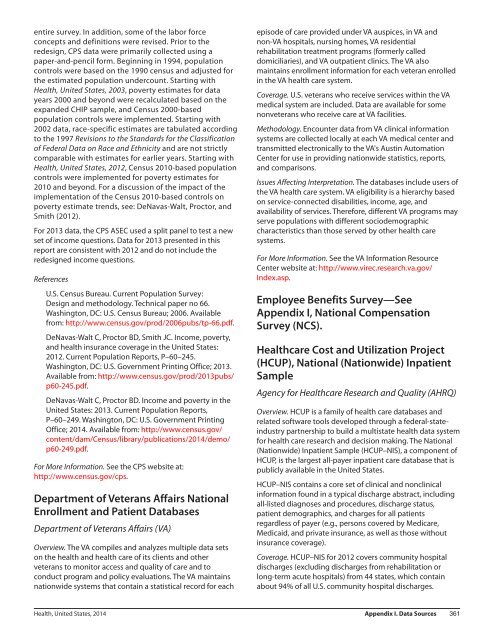hus14
hus14
hus14
Create successful ePaper yourself
Turn your PDF publications into a flip-book with our unique Google optimized e-Paper software.
entire survey. In addition, some of the labor force<br />
concepts and definitions were revised. Prior to the<br />
redesign, CPS data were primarily collected using a<br />
paper-and-pencil form. Beginning in 1994, population<br />
controls were based on the 1990 census and adjusted for<br />
the estimated population undercount. Starting with<br />
Health, United States, 2003, poverty estimates for data<br />
years 2000 and beyond were recalculated based on the<br />
expanded CHIP sample, and Census 2000-based<br />
population controls were implemented. Starting with<br />
2002 data, race-specific estimates are tabulated according<br />
to the 1997 Revisions to the Standards for the Classification<br />
of Federal Data on Race and Ethnicity and are not strictly<br />
comparable with estimates for earlier years. Starting with<br />
Health, United States, 2012, Census 2010-based population<br />
controls were implemented for poverty estimates for<br />
2010 and beyond. For a discussion of the impact of the<br />
implementation of the Census 2010-based controls on<br />
poverty estimate trends, see: DeNavas-Walt, Proctor, and<br />
Smith (2012).<br />
For 2013 data, the CPS ASEC used a split panel to test a new<br />
set of income questions. Data for 2013 presented in this<br />
report are consistent with 2012 and do not include the<br />
redesigned income questions.<br />
References<br />
U.S. Census Bureau. Current Population Survey:<br />
Design and methodology. Technical paper no 66.<br />
Washington, DC: U.S. Census Bureau; 2006. Available<br />
from: http://www.census.gov/prod/2006pubs/tp-66.pdf.<br />
DeNavas-Walt C, Proctor BD, Smith JC. Income, poverty,<br />
and health insurance coverage in the United States:<br />
2012. Current Population Reports, P–60–245.<br />
Washington, DC: U.S. Government Printing Office; 2013.<br />
Available from: http://www.census.gov/prod/2013pubs/<br />
p60-245.pdf.<br />
DeNavas-Walt C, Proctor BD. Income and poverty in the<br />
United States: 2013. Current Population Reports,<br />
P–60–249. Washington, DC: U.S. Government Printing<br />
Office; 2014. Available from: http://www.census.gov/<br />
content/dam/Census/library/publications/2014/demo/<br />
p60-249.pdf.<br />
For More Information. See the CPS website at:<br />
http://www.census.gov/cps.<br />
Department of Veterans Affairs National<br />
Enrollment and Patient Databases<br />
Department of Veterans Affairs (VA)<br />
Overview. The VA compiles and analyzes multiple data sets<br />
on the health and health care of its clients and other<br />
veterans to monitor access and quality of care and to<br />
conduct program and policy evaluations. The VA maintains<br />
nationwide systems that contain a statistical record for each<br />
episode of care provided under VA auspices, in VA and<br />
non-VA hospitals, nursing homes, VA residential<br />
rehabilitation treatment programs (formerly called<br />
domiciliaries), and VA outpatient clinics. The VA also<br />
maintains enrollment information for each veteran enrolled<br />
in the VA health care system.<br />
Coverage. U.S. veterans who receive services within the VA<br />
medical system are included. Data are available for some<br />
nonveterans who receive care at VA facilities.<br />
Methodology. Encounter data from VA clinical information<br />
systems are collected locally at each VA medical center and<br />
transmitted electronically to the VA's Austin Automation<br />
Center for use in providing nationwide statistics, reports,<br />
and comparisons.<br />
Issues Affecting Interpretation. The databases include users of<br />
the VA health care system. VA eligibility is a hierarchy based<br />
on service-connected disabilities, income, age, and<br />
availability of services. Therefore, different VA programs may<br />
serve populations with different sociodemographic<br />
characteristics than those served by other health care<br />
systems.<br />
For More Information. See the VA Information Resource<br />
Center website at: http://www.virec.research.va.gov/<br />
Index.asp.<br />
Employee Benefits Survey—See<br />
Appendix I, National Compensation<br />
Survey (NCS).<br />
Healthcare Cost and Utilization Project<br />
(HCUP), National (Nationwide) Inpatient<br />
Sample<br />
Agency for Healthcare Research and Quality (AHRQ)<br />
Overview. HCUP is a family of health care databases and<br />
related software tools developed through a federal-stateindustry<br />
partnership to build a multistate health data system<br />
for health care research and decision making. The National<br />
(Nationwide) Inpatient Sample (HCUP–NIS), a component of<br />
HCUP, is the largest all-payer inpatient care database that is<br />
publicly available in the United States.<br />
HCUP–NIS contains a core set of clinical and nonclinical<br />
information found in a typical discharge abstract, including<br />
all-listed diagnoses and procedures, discharge status,<br />
patient demographics, and charges for all patients<br />
regardless of payer (e.g., persons covered by Medicare,<br />
Medicaid, and private insurance, as well as those without<br />
insurance coverage).<br />
Coverage. HCUP–NIS for 2012 covers community hospital<br />
discharges (excluding discharges from rehabilitation or<br />
long-term acute hospitals) from 44 states, which contain<br />
about 94% of all U.S. community hospital discharges.<br />
Health, United States, 2014 Appendix I. Data Sources 361


